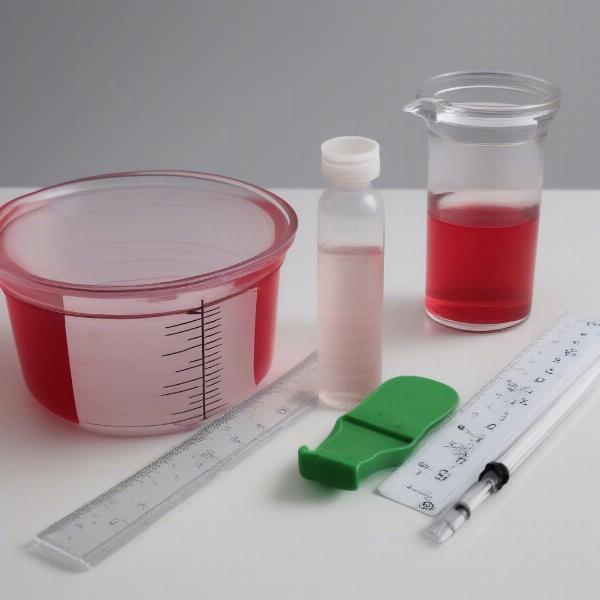Hibiscrub, a popular antiseptic solution containing chlorhexidine gluconate, can be a valuable tool in your dog’s first-aid kit. Understanding how to use Hibiscrub for dogs correctly is essential for effectively treating minor wounds and skin conditions while avoiding potential complications. This guide provides a comprehensive overview of using Hibiscrub safely and effectively on your canine companion.
Understanding Hibiscrub and its Uses for Dogs
Hibiscrub is an effective antiseptic against bacteria, fungi, and some viruses. For dogs, it’s primarily used to clean minor wounds, abrasions, hot spots, and skin infections. It can also be helpful in managing certain skin conditions like pyoderma. However, it’s crucial to consult your veterinarian before using Hibiscrub, especially if your dog has a deep wound, puncture wound, or severe skin condition.
Preparing Hibiscrub Solution for Dogs
Hibiscrub is usually sold as a concentrate and needs to be diluted before use on dogs. The typical dilution is one part Hibiscrub to 40 parts water, creating a 2.5% solution. Always follow the instructions on the product label for the specific dilution ratio. Using a higher concentration than recommended can irritate your dog’s skin. Mix the solution thoroughly in a clean container.
 Preparing Hibiscrub Solution for Dogs
Preparing Hibiscrub Solution for Dogs
Applying Hibiscrub to Your Dog
Before applying the solution, gently clean the affected area with warm water and remove any loose debris or dirt. Soak a clean cotton ball or gauze pad in the diluted Hibiscrub solution and gently dab it onto the affected area. Avoid rubbing or scrubbing, which can further irritate the skin. Allow the solution to air dry. Repeat this process two to three times a day as directed by your veterinarian.
When to Avoid Using Hibiscrub on Dogs
While generally safe, Hibiscrub isn’t suitable for all situations. Avoid using it:
- Near the eyes or ears: The solution can cause irritation and damage to these sensitive areas.
- On deep wounds or puncture wounds: These require professional veterinary attention.
- If your dog is allergic to chlorhexidine: Allergic reactions can range from mild skin irritation to more severe symptoms.
Monitoring Your Dog After Hibiscrub Application
After applying Hibiscrub, monitor your dog for any signs of skin irritation, such as redness, swelling, or excessive licking. If you notice any of these signs, discontinue use and consult your veterinarian. Some dogs may ingest the solution while licking the treated area. While small amounts are unlikely to cause serious harm, excessive ingestion can lead to gastrointestinal upset. Prevent your dog from licking the treated area by using an Elizabethan collar or a bitter-tasting spray.
What if my dog licks the Hibiscrub?
If your dog licks the Hibiscrub-treated area, don’t panic. Small amounts are unlikely to cause harm. However, if they ingest a significant amount, it could lead to gastrointestinal upset. Observe them for any unusual symptoms like vomiting or diarrhea, and consult your veterinarian if you’re concerned. Dr. Emily Carter, DVM, advises, “While Hibiscrub is generally safe for topical use in dogs, ingestion can cause mild stomach upset. If you notice any unusual symptoms after your dog licks a treated area, it’s always best to consult a veterinarian.”
Conclusion
Hibiscrub can be a useful addition to your dog’s first-aid arsenal. By following these guidelines on how to use Hibiscrub for dogs, you can effectively treat minor wounds and skin conditions. Remember to always consult your veterinarian before using Hibiscrub, especially for more serious injuries or persistent skin problems.
FAQ
- How often can I use Hibiscrub on my dog? Generally, two to three times a day is sufficient. Always follow your veterinarian’s instructions.
- Can I use Hibiscrub on my puppy? Yes, but always consult your veterinarian first, as puppies may have more sensitive skin.
- What should I do if my dog’s skin becomes irritated after using Hibiscrub? Discontinue use immediately and contact your veterinarian.
- Is Hibiscrub safe to use around my dog’s eyes? No, avoid using Hibiscrub near the eyes or ears.
- Can I use Hibiscrub on a deep wound? No, deep wounds require professional veterinary care.
- What is the correct dilution for Hibiscrub for dogs? Typically, one part Hibiscrub to 40 parts water, but always check the product label.
- What are the alternatives to Hibiscrub for dogs? Other antiseptic solutions are available, but it’s essential to consult your veterinarian for recommendations.
ILM Dog is a leading online resource dedicated to providing expert advice on dog care, health, training, and more. We offer a wealth of information to help dog owners worldwide provide the best possible care for their canine companions. From breed selection and puppy care to senior dog health and product recommendations, we cover all aspects of dog ownership. We also offer expert insights into dog behavior, nutrition, grooming, and travel. For any queries or concerns, feel free to contact us via email at [email protected] or call us at +44 20-3965-8624. ILM Dog is your trusted partner in your dog’s journey, offering reliable and practical advice every step of the way.